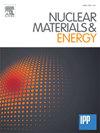基于机器学习的氢回收模型,通过分子动力学模拟预测钨材料上释放的氢分子的旋转振动分布
IF 2.3
2区 物理与天体物理
Q1 NUCLEAR SCIENCE & TECHNOLOGY
引用次数: 0
摘要
了解氢循环过程对于理解核聚变装置中分离等离子体的行为至关重要。为了实现这一目标,正在开发分子动力学(MD)模型来预测从等离子体面材料中释放的氢原子和分子的平动能和旋转振动态的分布。中性输运模拟,利用从MD模型得到的分布作为边界条件,也是分析循环氢对边缘等离子体影响的有力工具。然而,MD模型需要大量的计算资源来获得不同材料和辐照条件下的分布,如材料温度和入射能量。因此,开发有效的模型,将中性输运模拟与氢回收模型无缝集成是至关重要的。机器学习技术用于开发能够预测释放的氢原子和分子的能量分布和旋转振动状态的预测模型。在此基础上,将单色分布与偏移麦克斯韦分布进行积分,建立了考虑入射能量分布(偏移麦克斯韦分布)的模型。本文章由计算机程序翻译,如有差异,请以英文原文为准。
Machine learning-based hydrogen recycling model for predicting rovibrational distributions of released molecular hydrogen on tungsten materials via molecular dynamics simulations
Understanding the hydrogen recycling process is crucial for comprehending the behavior of detached plasma in nuclear fusion devices. To achieve this, a molecular dynamics (MD) model is being developed to predict the distribution of translational energies and rovibrational states of hydrogen atoms and molecules released from the plasma-facing materials. Neutral transport simulations, utilizing distributions obtained from the MD model as boundary conditions, are also a powerful tool for analyzing the impact of recycled hydrogens on edge plasma. However, the MD model requires significant computational resources to obtain distributions under varying material and irradiation conditions such as material temperature and incident energy. Therefore, developing effective models that seamlessly integrate neutral transport simulation with hydrogen recycling models is crucial. Machine learning techniques are employed to develop predictive models capable of forecasting distributions of energies and rovibrational states of released hydrogen atoms and molecules. Furthermore, a model considering the incident energy distribution (shifted-Maxwellian) is developed by integrating the monochromatic distribution with the shifted-Maxwellian distribution.
求助全文
通过发布文献求助,成功后即可免费获取论文全文。
去求助
来源期刊

Nuclear Materials and Energy
Materials Science-Materials Science (miscellaneous)
CiteScore
3.70
自引率
15.40%
发文量
175
审稿时长
20 weeks
期刊介绍:
The open-access journal Nuclear Materials and Energy is devoted to the growing field of research for material application in the production of nuclear energy. Nuclear Materials and Energy publishes original research articles of up to 6 pages in length.
 求助内容:
求助内容: 应助结果提醒方式:
应助结果提醒方式:


